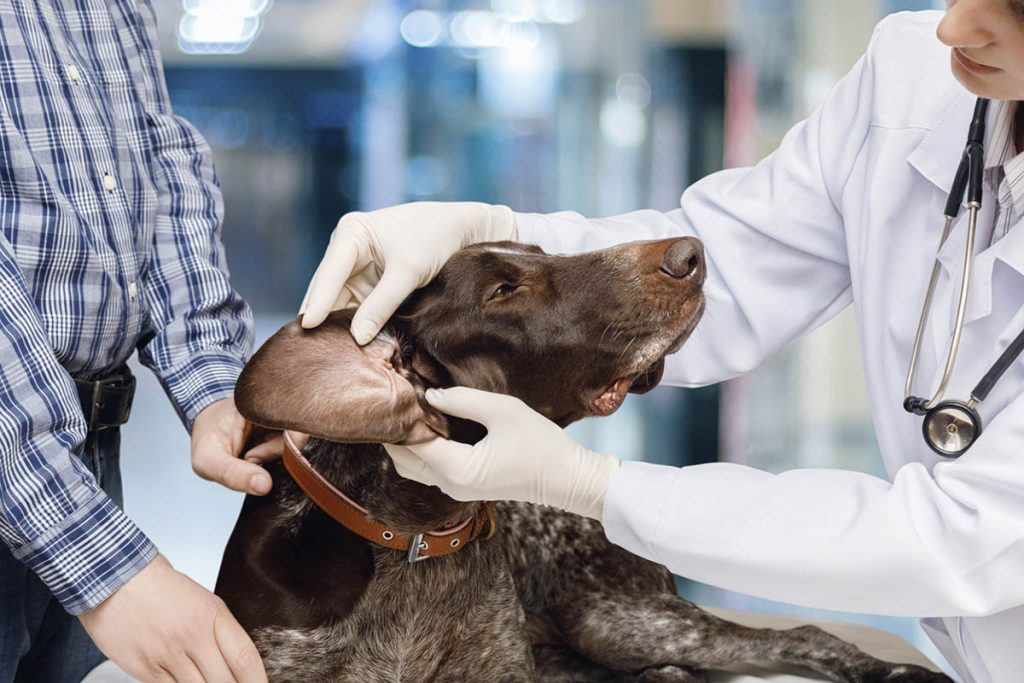Every loving pet parent worries when they think their best friend is feeling ill. One of the first things you wonder about is if your pooch has a fever. But what is the normal temperature for dogs? How can you tell if a dog has a fever?
Many people believe they can tell by feeling their dog’s nose if he has a fever, but that’s an oversimplification at best. The story goes that cool and wet is normal, and hot and dry means the dog’s body temperature is high.
There may be some instances where a warm, dry nose may indicate the presence of a fever, but it’s not the only reason for that. A warm, dry nose can be caused by other things like the dog being inside a home with dry air or having had their head covered, thus causing their nose to feel warm.
Also, how warm is warm when you’re feeling your dog’s nose? That’s the same problem with feeling your dog’s ears. And like with his nose, your dog might have warm ears for reasons not related to any fever or illness. Moreover, while your dog’s ears should be room temperature or slightly warmer, it can be difficult to detect a high temperature with your hands.
Part of the problem with detecting fever in dogs is that their normal body temperature ranges from 100.5 to 102.5 degrees Fahrenheit, which is higher than your normal body temperature. So, let’s talk about what constitutes a fever in dogs, what are the common signs of a fever, what causes fevers in dogs, and what you should do about it.
What Temperature Is a Dog’s Fever?

Dogs naturally run hotter than humans. As mentioned, their normal body temperature is between 100.5 and 102.5 degrees Fahrenheit; that compares to 97.6 to 99.6 degrees Fahrenheit for humans. What that means is that your dog could feel hot to you simply because his body temperature is normally hotter than yours.
When we talk about dog fever, that usually means his body temperature is above 103 degrees Fahrenheit. A temperature above 105 degrees Fahrenheit, is a high fever. If it is above 106 degrees Fahrenheit, it is a medical emergency and can cause fatal complications. In summary:
- 100.5-102.5: Normal body temperature
- >103: Fever
- >105: High fever
- >106: Medical emergency
Temperatures above 106 degrees cause cerebral edema (brain swelling), suppress the bone marrow, which is where most of the blood cells are made, and can result in clotting disorders. Such a high fever can also cause seizures, and of course, your dog will feel very lethargic.
It is important to note that it’s possible an excited or stressed dog could have a low-grade fever of 103 degrees or a little more, but that shouldn’t persist once the source of the excitement or stress is no longer a problem.
Why Do Dogs Spike a Fever?
Fever is actually part of the body’s defense mechanisms against infections. Research shows that the heat generated by a fever helps improve the performance of immune cells while creating stress for pathogens, like bacteria and viruses, and infected cells.
Additionally, the presence of a fever combines with other stressors to stimulate the body’s general immune defense response. Fever actually mobilizes certain immune system cells, like lymphocytes, as it shapes the form of immune cell function.
The fact that fever has been present in both warm and cold-blooded vertebrates for over 600 million years suggests that it must confer a survival advantage. However, not all fevers are beneficial. If they persist, fevers can lead to anorexia, lethargy, and dehydration.
This is why it’s necessary to take action when your pooch’s body temperature rises above 106 degrees Fahrenheit. So what causes fever in dogs?
What Causes Dog Fever?

There are a number of things that can cause fever in dogs. Here are some of the more common causes of fever in dogs:
- Infections — An infection can be caused by some kind of pathogen, be it bacterial, fungal, or viral, as it proliferates in your dog’s body. The underlying cause of the infection can range from something like an infected bite to exposure to a viral disease. An infection can be located anywhere in the body, including the kidneys (pyelonephritis), the brain (encephalitis), the bladder (urinary tract infection or UTI), or the lungs (pneumonia). Some infections, notably fungal diseases, can affect numerous areas of the body simultaneously.
- Vaccinations — Vaccines often stimulate a low-grade fever for 24 – 48 hours as your dog’s immune system responds to the vaccine. Vaccines contain either a modified live or killed form of the pathogen the vaccine is designed to prevent. A fever simply indicates the vaccine is doing what it’s designed to do by stimulating an immune response.
- Toxins — Toxic plants and other toxic substances can increase your dog’s body temperature. Your dog might get ahold of certain toxic human medications, notably antidepressants, around the house. Of course, there are also human foods that are toxic as well. If consumed, your dog might spike a fever.
- Fever of Unknown Origin (FUO) — Sometimes, the cause of dog fever cannot be readily identified. This is called a fever of unknown origin, or FUO. Research shows that a ‘true FUO’ is very rare, occurring in only about 6% of cases of fever. Infectious diseases and immune-related diseases were the most common causes of fever, but cancer and congenital diseases also increased dogs’ body temperature.
What are the Symptoms of a Fever in Dogs?
Depending on the underlying cause of the fever, your dog’ might exhibit a variety of symptoms. So, what are those symptoms, and how can you tell if your dog has a fever?
Your dog’s symptoms of fever might vary depending on the cause, but there are several red flags that could indicate fever. Here are a few:
- Lethargy
- Shivering
- Depression
- Loss of appetite
- Vomiting
- Nasal discharge
- Red or glassy-looking eyes
- Coughing
- Unexplained warm ears and/or nose
- Seizures
How Can You Take Your Dog’s Temperature?
The only way to accurately tell if your dog has a fever is to take his temperature. The most accurate method is to use a rectal thermometer. The ear thermometers that are made for human ears do not work as well for dogs because they tend to present a lower temperature than that taken rectally.
So, how do you take a rectal temperature?
The first thing to do is coat the thermometer with a lubricant like petroleum jelly or baby oil. Then, gently insert the tip of the thermometer into your dog’s rectum and hold it there for about 1 – 2 minutes. If you’re using a digital thermometer, it usually takes around 60 seconds for the temperature to register. Write down the temperature you get.
When Should You Seek Veterinary Care?

If your dog’s fever is above 106 degrees, you should seek veterinary care immediately. If it’s greater than 105 degrees but under 106, apply cool water to their fur and around their ears and feet to cool them down. Call your vet just in case.
You can also put a fan on the damp fur to help lower the temperature. If you try to cool your dog down using this method, measure your dog’s temperature regularly. Stop the cooling process when it reaches 103 degrees. It’s important not to bring the temperature down too quickly.
You can also offer your dog small amounts of water to help them cool down and stay hydrated. However, do not force this. If the fever isn’t above 106 degrees but persists for more than 24 – 48 hours, seek veterinary care.
Whatever you do, NEVER give any human medicines, such as ibuprofen or acetaminophen, to your dog to bring down his fever. Human medications can be poisonous to your dog, resulting in severe injury or even death.
How Will Your Veterinarian Treat Your Dog’s Fever?
Treatment for dog fevers depends on the cause of the fever. If you take your dog to the veterinarian, they will begin with certain diagnostic tests. These include bloodwork, radiographs (X-rays), or cytological, bacterial, or fungal cultures, as necessary to determine the underlying cause of the fever.
While infectious disease is a common cause of fever, research finds a high incidence of immune-mediated diseases and inflammatory central nervous system diseases as the underlying causes of fever.
If the cause of your dog’s fever is an infectious disease, they may get a course of antibiotics or antifungal medications. If the cause is some other type of disease, your dog may get medications to alleviate the symptoms until the inflammatory response that stimulates the fever subsides. Depending on the level of severity, those can take anywhere from a few days to weeks to work.
Cancer is typically treated with chemotherapy and/or radiation therapy. The response to treatment varies. Autoimmune diseases are usually treated with drugs that suppress your dog’s immune system to stop the attack.
It’s important to note that non-infectious causes of fever are manageable but not curable. That may mean it is necessary to treat your dog for a long time or for the rest of his life.
If Your Dog’s Hot, You Stay Cool
Perhaps the most important thing you can do if you discover your dog has a fever is to remain calm. You can try to cool him down using the techniques described above. If the fever persists or is above 106, get him to the veterinarian for a check-up.
